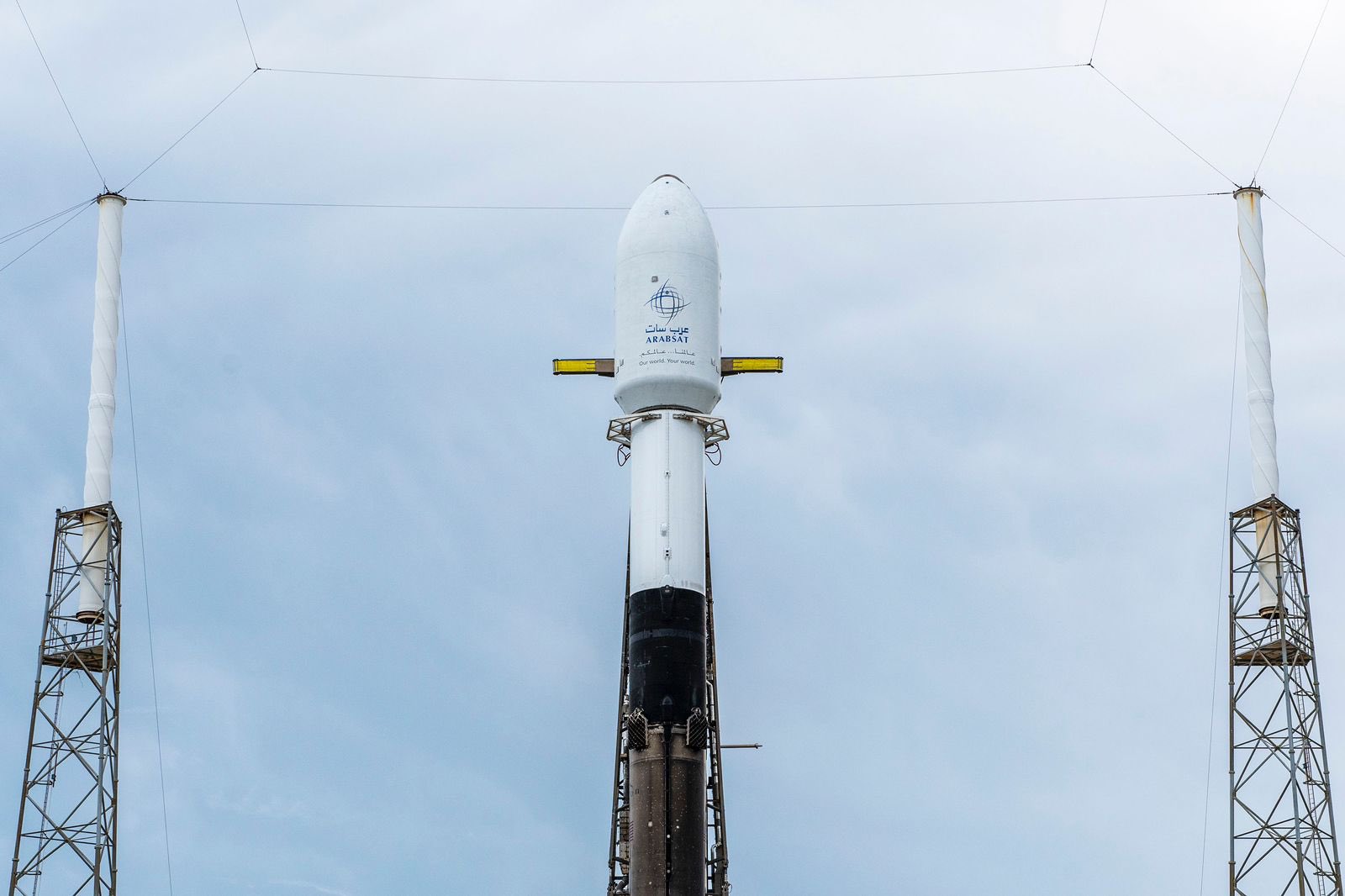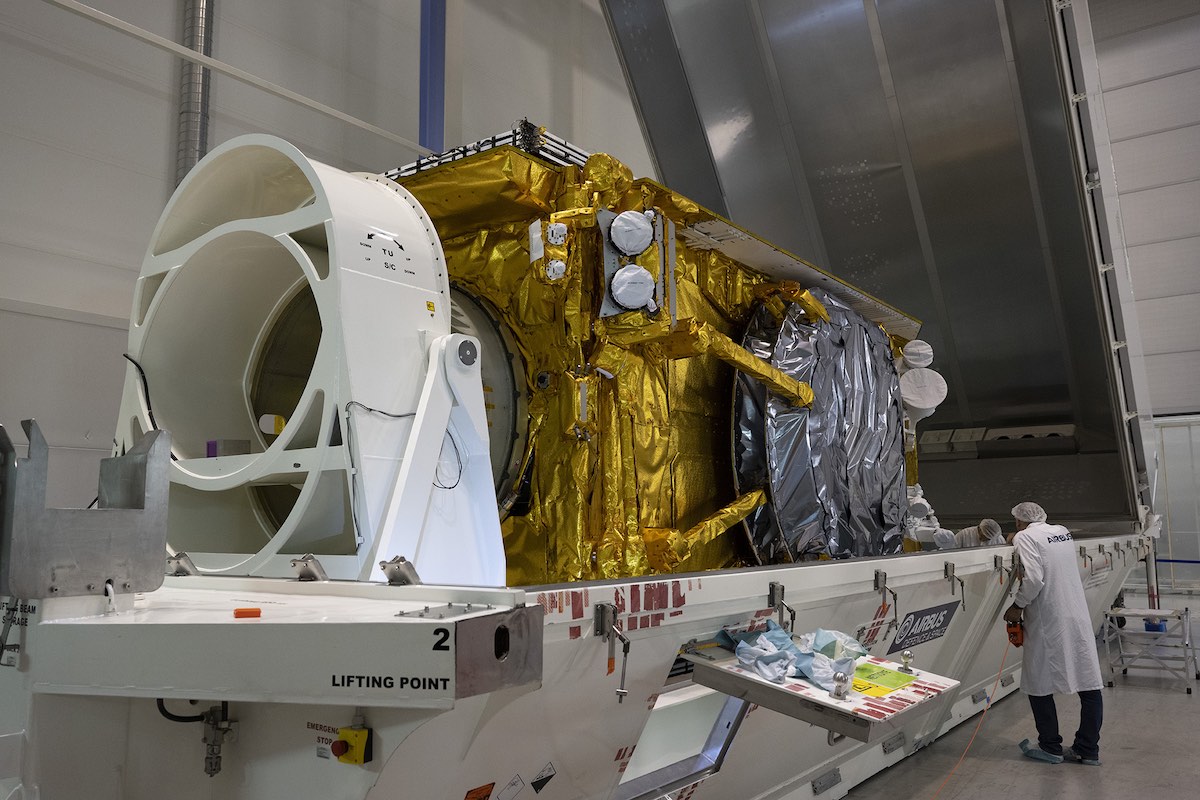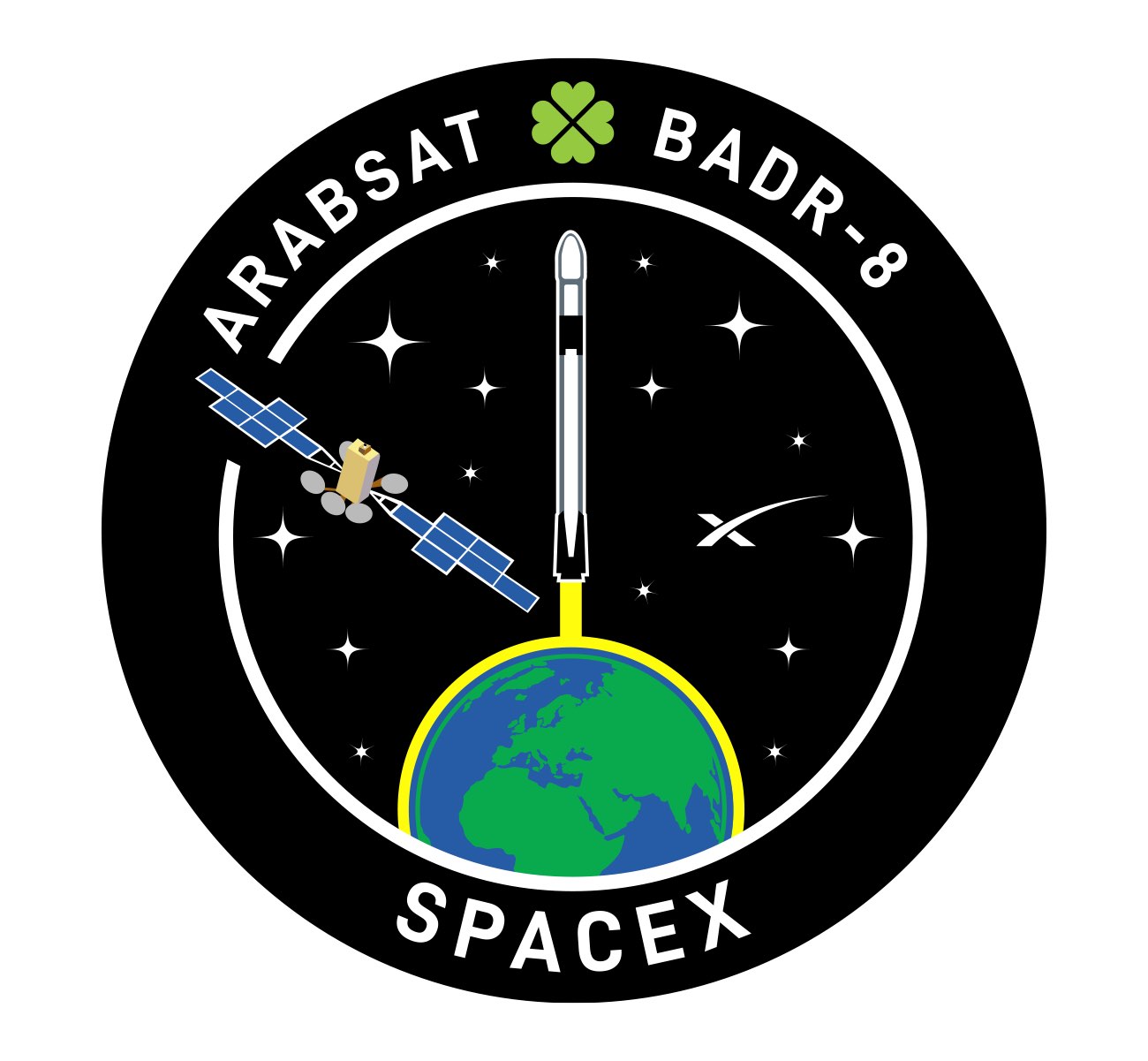Space News & Blog Articles
Watch live: SpaceX ready for launch of Arabsat telecom payload tonight
An Airbus-built communications satellite for Arabsat is buttoned up for liftoff Tuesday night from Cape Canaveral, but stormy weather threatens to delay the launch aboard a SpaceX Falcon 9 rocket.
The Falcon 9 has a launch window of more than two hours opening at 11:25 p.m. EDT Tuesday (0325 UTC Wednesday), but there’s just a 30% chance of favorable weather at the opening of the launch window. The forecast improves throughout the night, with a 50% chance of good weather at the end of the launch window at 1:32 a.m. EDT (0532 UTC).
After heading east from Cape Canaveral, the SpaceX launcher will deliver the Badr 8 satellite into an elliptical geostationary transfer orbit about a half-hour after liftoff.
The launch will mark SpaceX’s 36th flight of the year, and the 26th orbital launch attempt so far in 2023 from Florida’s Space Coast.
The nearly 10,000 pound (4.5-metric ton) Badr 8 communications satellite is closed up inside the Falcon 9’s nose cone. Built by Airbus Defense and Space, the Badr 8 satellite will provide C-band and Ku-band communications services to replace capacity currently offered by the aging 15-year-old Badr 6 satellite in geostationary orbit.
Badr 8 will move into position at the same orbital slot as Badr 8, located along the equator at 26 degrees east longitude. The Badr satellites are owned by Arabsat, a pan-Arab consortium of 21 member states based in Riyadh, Saudi Arabia. Badr 8 will provide television broadcast services, video relay, and data services across the Middle East and North Africa, Europe, and Central Asia.
Arabsat says its investment in the Badr 8 program totals about $300 million, including the spacecraft manufacturing contract with Airbus, the launch agreement with SpaceX, insurance, and ground infrastructure.
 SpaceX’s Falcon 9 rocket stands on pad 40 at Cape Canaveral Space Force Station in preparation for liftoff with the Badr 8 communications satellite for Arabsat. Credit: SpaceX
SpaceX’s Falcon 9 rocket stands on pad 40 at Cape Canaveral Space Force Station in preparation for liftoff with the Badr 8 communications satellite for Arabsat. Credit: SpaceX
Badr 8 is based on Airbus’s Eurostar Neo satellite platform, the company’s newest large spacecraft bus. After separation from the Falcon 9 rocket about 37 minutes into the mission, Badr 8 will unfurl its solar panels and run through a series of post-launch checkouts under the supervision of Airbus ground controllers in Toulouse, France.
Then Badr 8 will use low-thrust, high-efficiency plasma thrusters to maneuver into a circular geostationary orbit more than 22,000 miles (nearly 36,000 kilometers) over the equator, settling into an orbit that matches the speed of Earth’s rotation, giving the spacecraft a constant view of its coverage zone stretching from Europe, to the Middle East, and into Central Asia.
The orbital adjustments will take several months, then Badr 8 will complete in-orbit testing and should be ready to commence operational service for Arabsat later this year. The Badr 8 spacecraft is designed for a 15-year service life.
Besides its purpose as a commercial communications satellite, Badr 8 also hosts an experimental laser communications payload for Airbus. The TELEO demonstration will test new optical communications technology in a partnership between Airbus, the French space agency CNES, and Safran Data Systems.
The TELEO payload will test the technology’s ability to beam data from the satellite to a ground station using lasers, allowing for the transfer of information at up to 10 gigabits per second. Airbus and its partners hope to advance the technology for future missions to achieve a one terabit per second bit rate using optical communications.
“This TELEO demonstrator will also enable very high capacity optical feeder link communications, by nature highly robust against jamming, as part of the development by Airbus of a new generation of optical communications technology in space,” Airbus said in a press release.
 The Badr 8 satellite satellite being prepared for shipment to Cape Canaveral from Airbus’s factory in Toulouse, France. Credit: Airbus
The Badr 8 satellite satellite being prepared for shipment to Cape Canaveral from Airbus’s factory in Toulouse, France. Credit: Airbus
The launch of Badr 8, if it occurs Tuesday night, will cap a jam-packed sequence of SpaceX missions. It will be the fourth SpaceX Falcon 9 launch in less than five days, following a Falcon 9 flight with Starlink satellites May 19 from Cape Canaveral, a Falcon 9 launch from California Saturday with payloads for OneWeb and Iridium, and the launch of Axiom Space’s Ax-2 private astronaut mission Sunday from Kennedy Space Center in Florida.
Working out of SpaceX’s launch and landing control center just south of Cape Canaveral Space Force Station, engineers will oversee the late-night countdown leading up to liftoff of the Badr 8 mission Tuesday night. The Falcon 9 rocket will be filled with a million pounds of kerosene and liquid oxygen propellants in the final 35 minutes before liftoff.
After teams verify technical and weather parameters are all “green” for launch, the nine Merlin 1D main engines on the first stage booster will flash to life with the help of an ignition fluid called triethylaluminum/triethylborane, or TEA-TEB. Once the engines ramp up to full throttle, hydraulic clamps will open to release the Falcon 9 for its climb into space.
The nine main engines will produce 1.7 million pounds of thrust for more than two-and-a-half minutes, propelling the Falcon 9 and Badr 8 into the upper atmosphere. Then the booster stage will shut down and separate from the Falcon 9’s upper stage to begin a controlled descent toward SpaceX’s drone ship “Just Read the Instructions” parked in the Atlantic Ocean.
 SpaceX’s mission patch for the Badr 8 mission, with illustrations of the Falcon 9 rocket and the Badr 8 spacecraft with its solar panels unfurled. Credit: SpaceX
SpaceX’s mission patch for the Badr 8 mission, with illustrations of the Falcon 9 rocket and the Badr 8 spacecraft with its solar panels unfurled. Credit: SpaceX
The booster, designated B1062, will extend titanium hypersonic grid fins and use cold gas nitrogen thrusters to control its orientation, then reignite three of its nine main engines for a nearly 30-second braking maneuver during re-entry. A final landing burn with just the center engine will slow the rocket for touchdown on the drone ship about eight-and-a-half minutes into the mission.
A SpaceX recovery ship is also in position in the Atlantic to recover the Falcon 9 rocket’s payload fairing after the nose cone’s two clamshell halves parachute into the sea. The payload fairing will jettison from the rocket about three-and-a-half minutes into the flight, shortly after ignition of the Falcon 9’s upper stage engine.
The Falcon 9 rocket will fire its upper stage engine two times to inject the Badr 8 spacecraft into an elliptical supersynchronous transfer orbit. Separation of Badr 8 from the Falcon 9’s upper stage is expected at T+plus 37 minutes, 13 seconds.
ROCKET: Falcon 9 (B1062.14)
PAYLOAD: Badr 8 communications satellite
LAUNCH SITE: SLC-40, Cape Canaveral Space Force Station, Florida
LAUNCH DATE: May 23/14, 2023
LAUNCH WINDOW: 11:25 p.m.-1:32 a.m. EDT (0325-0532 UTC)
LAUNCH WINDOW: Instantaneous
WEATHER FORECAST: 30-50% probability of acceptable weather
BOOSTER RECOVERY: “Just Read the Instructions” drone ship in the Atlantic Ocean
LAUNCH AZIMUTH: East
TARGET ORBIT: Supersynchronous transfer orbit
LAUNCH TIMELINE:
T+00:00: Liftoff T+01:12: Maximum aerodynamic pressure (Max-Q) T+02:33: First stage main engine cutoff (MECO) T+02:36: Stage separation T+02:44: Second stage engine ignition T+03:22: Fairing jettison T+06:29: First stage entry burn ignition (three engines) T+06:51: First stage entry burn ends T+08:10: Second stage engine cutoff (SECO 1) T+08:23: First stage landing burn ignition (one engine) T+08:44: First stage landing T+29:03: Second stage engine restart T+30:02: Second stage engine cutoff (SECO 2) T+37:13: Intelsat 40e separationMISSION STATS:
227th launch of a Falcon 9 rocket since 2010 238th launch of Falcon rocket family since 2006 14th launch of Falcon 9 booster B1062 192nd Falcon 9 launch from Florida’s Space Coast 126th Falcon 9 launch from pad 40 181st launch overall from pad 40 168th flight of a reused Falcon 9 booster 2nd SpaceX launch for Arabsat 33rd Falcon 9 launch of 2023 36th launch by SpaceX in 2023 26th orbital launch attempt based out of Cape Canaveral in 2023This email address is being protected from spambots. You need JavaScript enabled to view it. the author.
Follow Stephen Clark on Twitter: @StephenClark1.
When you subscribe to the SpaceZE News Feed, we will send you an e-mail when there are new updates on the site so you wouldn't miss them.

